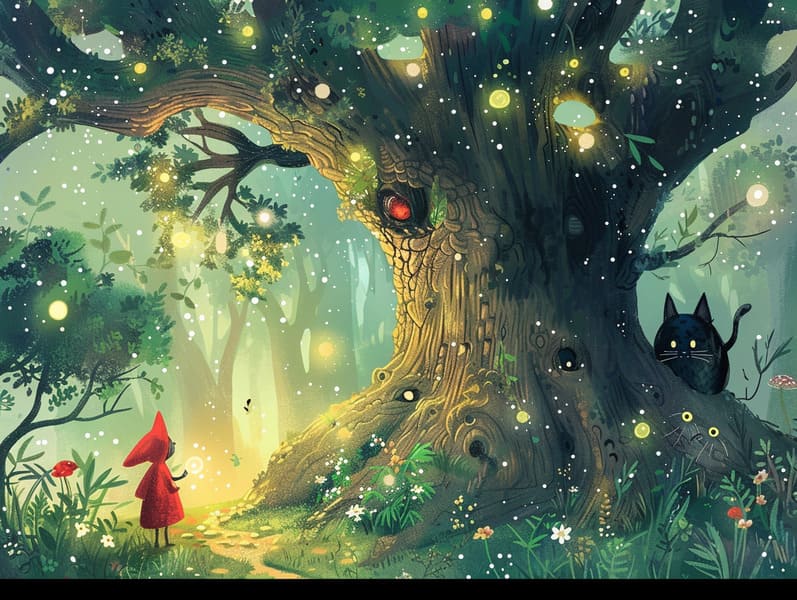
Short fairy tales have enduring presence. These tales have been relayed from one generation to the next millennia before they were ever written down. They sprang from a variety of civilizations, including American traditions. They were initially conveyed among grown-ups, often carrying themes and messages relevant to the societal norms and beliefs of the time.
Jacob and Wilhelm Grimm, Jacob and Wilhelm (the Grimm brothers), were among the first to gather and publish many of these beloved narratives. Their published works, "Grimm's Story Collection," included stories like "The True Bride," "Little Brother and Little Sister," and "The True Story of Snow White," which have since become essentials in the world of iconic fairy tales. Similarly, Andersen's fanciful stories, such as "The Story of the Little Mermaid," and "The Story of the Ugly Duckling," have enchanted hearts worldwide, guaranteeing their place in the pantheon of treasured fairy tales.
Though they are old, fairy tales remain as meaningful as ever, especially as nighttime stories for kids. These fantastical tales are now available in various formats, including colorful picture books, delightful animations, and online storybooks.
Their continued relevance can be credited to several captivating elements:
Life Lessons: Timeless fairy tales often whisper important moral lessons. Narratives like "The Boy Who Cried Wolf" teach the merit of sincerity, while "The Hare and the Tortoise" stress the benefits of perseverance and unpretentiousness. These tales offer little ones clear distinctions between right and wrong, building their moral compass in a gentle yet significant way.
Compassion and Knowledge: Traditional fairy tales frequently include characters facing tests and troubles, encouraging listeners to identify with their struggles and champion their triumphs. For instance, "Beauty and Her Beast" highlights the importance of looking beyond appearances to know the inner core of a soul, advancing tenderness and comprehension.
Cultural Perception: Many classic fairy tales are saturated in the cultural contexts from which they emerged. Understanding these stories can provide intriguing perspectives into different societies, building a sense of global respect and perception.
Creativity and Fantasy: The imaginative elements in classic fairy tales—magical beings—boost children’s fantasy worlds. These stories guide readers to fantasy website realms, fostering innovative thinking and a sense of magic that stays a lifetime.
Traditional fairy tales are not only charming but also edifying. They act as whimsical tools in advancing various thinking and feeling skills in children. When fairy tales are recited, they strengthen speaking abilities by introducing new words and elaborate sentence structures. This practice also fosters listening abilities and concentration, as children follow the story, enthusiastic to see what happens next.
Furthermore, reflecting on the themes and characters of classic fairy tales can advance logical thinking and thinking skills. The young are led to recognize patterns, expect results, and figure out cause and effect. These talks also ease young ones verbalize their thoughts and feelings, fostering their emotional intelligence.
In today’s digital age, the proliferation of internet fairy tales has made these tales more attainable than ever. Digital sites and digital apps extend large libraries of famous fairy tales that can be browsed or listened to anytime, anywhere. Fairy tales voiced are particularly liked, sharing an fun way for kids to enjoy these enchanting tales. Read-aloud stories and read-out-loud stories guide characters and settings to life, often paired with entrancing background sounds and music that improve the narrative experience.
The unending appeal of traditional fairy tales lies in their ability to adjust to present eras while sustaining their fundamental ideas. Contemporary versions of these fairy tales often bring in more multicultural figures and modern settings, making them understandable to today’s audience. However, the main ideas of boldness, understanding, and fair-mindedness remain unchanged, continuing to resonate with children of all ages.
Classic fairy tales also offer a sense of serenity and understanding. They provide a well-arranged narrative with a obvious beginning, middle, and end, often wrapping up with the closure of conflicts and the triumph of righteousness over wickedness. This predictability can be comforting for young ones, bringing a sense of invariability in an unstable world.
Ancient fairy tales continue to enthrall and enlighten new generations, maintaining their captivation and applicability in modern society. As kids' bedtime tales, they disclose a perfect blend of charm and understanding, supporting moral values, empathy, and creativity. The proliferation of web-based fairy tales and the favor of fairy tales narrated affirm that these timeless tales remain accessible to new generations.
By keeping and narrating these narratives, we continue to value the rich tapestry of mythology and cultural heritage. Whether you are experiencing a beautifully illustrated book, seeing a virtual library, or listening to an narrated book, the elegance of traditional fairy tales is always within reach. These narratives convey of the persistent magic of tales and its ability to connect us across eras and regions.
If you are perusing a vibrantly illustrated book, delving into a electronic library, or hearing an read-aloud book, the allure of old fairy tales is always within reach.
These narratives illustrate of the persistent ability of narratives and its ability to draw us together across epochs and places, creating a bond that delights and instructs alike.